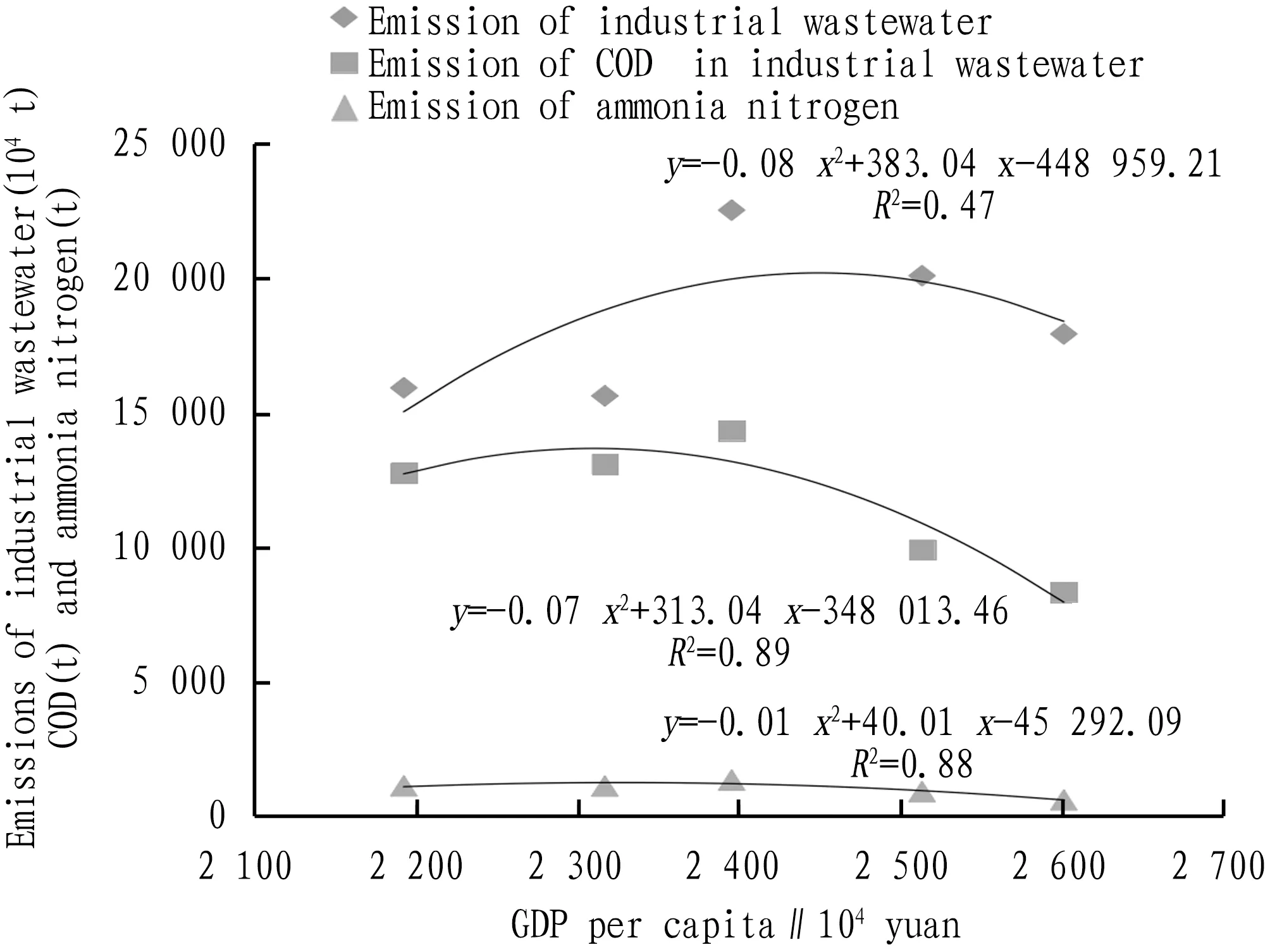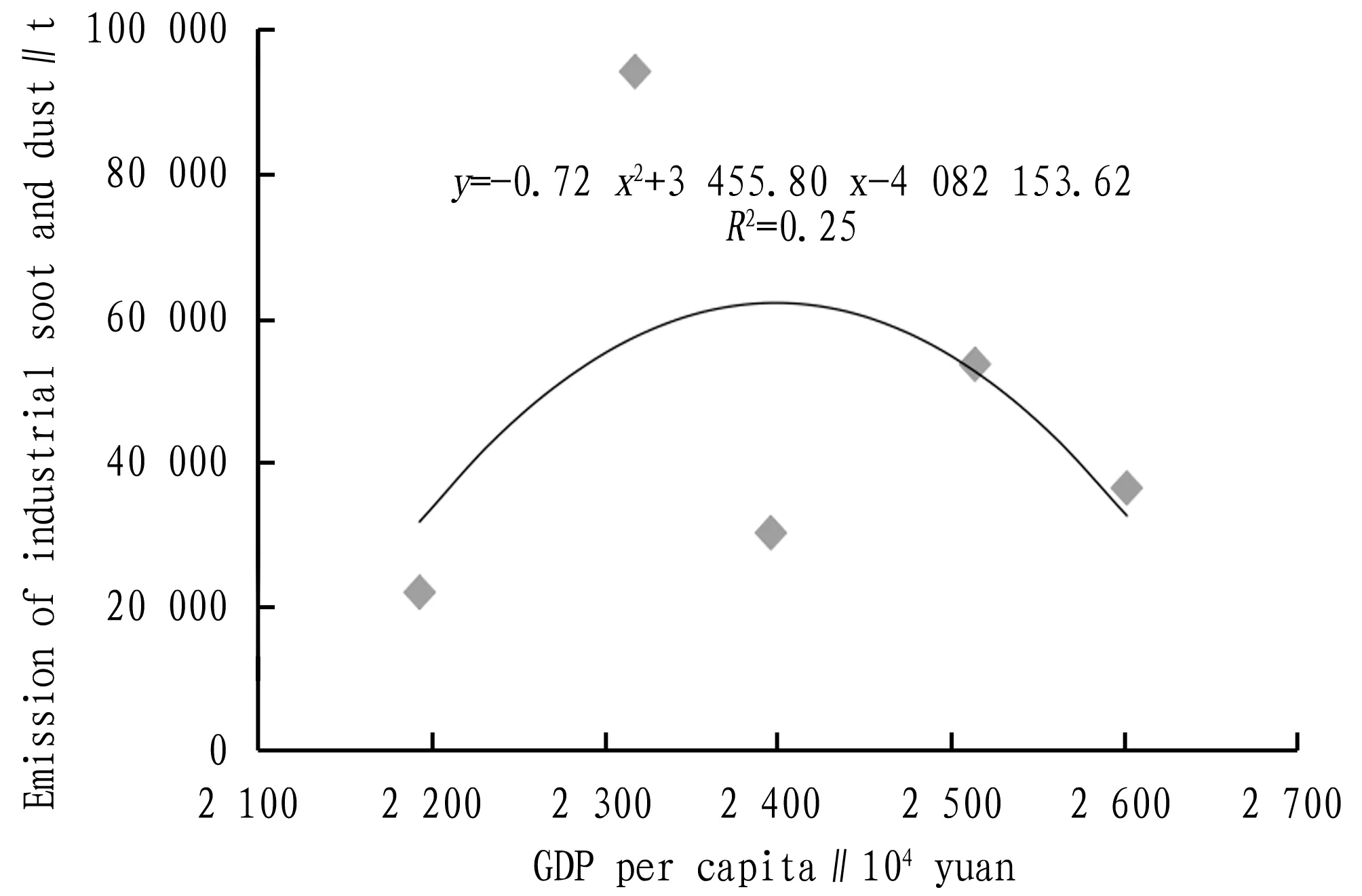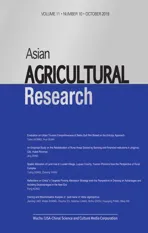Coordinated Development Level of Economic Society and Ecological Environment in Binzhou City
2019-11-20
College of Biological and Environmental Engineering, Binzhou University, Binzhou 256600, China
Abstract Based on the data of GDP per capita and emissions of major pollutants in Binzhou City from 2013 to 2017, the changing trends of emissions of major pollutants with the increase of GDP per capita, as well as the coordinated development level of ecological environment and social economy in Binzhou City were studied. The results showed that with the increase of GDP per capita, the changing curves of industrial wastewater and industrial soot in Binzhou City were inverted- U- shaped, and the emission of industrial wastewater reduced after peaking. However, the production of industrial solid waste and the emission of industrial waste gas did not show a downward trend with economic growth, and still increased year by year. The coordination degree of economic development and ecological environment protection in Binzhou City was moderately lagged. By the adjustment of industrial structure, environmental protection and control should be increased, and relevant regulations should be formulated to control pollutant emissions, thereby achieving sustainable development and coordinated development of regional ecology and environment.
Key words Regional economy, Environmental protection, Coordinated development
1 Introduction
The necessity of coordinated development of regional economy and the increasing severity of environmental problems have forced people to deeply reflect on how the economy and the ecological environment are coordinated. The ecological environment is the foundation of social and economic development, and greatly affects social and economic development. The social economy has an action on the ecological environment, promoting or hindering the ecological environment. The ecological environment is a resource and an asset, and it is a potential development advantage and benefit[1]. When the carrying capacity of the ecological environment is greater, social and economic development will also be positively affected. The effective use and protection of the ecological environment depends on the development of social economy, and the low- carbon circular form of social and economic development promotes the sustainable development of the ecological environment. On the contrary, it will increase the damage to the ecological environment. Binzhou City is located in the lower reaches of the Yellow River, Lubei Plain, and the hinterland of the Yellow River Delta. It plays an important role in the construction of an efficient ecological economic zone in the Yellow River Delta. A correct understanding of the relationship between environmental pollution and economic growth in the region is of great significance for the coordinated development of the environment and economy in the region[2]. In this paper, based on the statistical data of Binzhou City and counties from 2013 to 2017, the evaluation indicator system of coordinated development of economic society and ecological environment was constructed, and the coupling coordination degree model was used to measure the coordinated development level of ecological environment and social economy in Binzhou City and counties, which can provide decision- making basis for the transformation strategy of economic development in the city[3-4].
2 Problems existing in the development of circular economy in Binzhou City
For the counties and districts in Binzhou City, there still exist some problems in the development of circular economy. For instance, there is a vague understanding of the development of circular economy, the lack of technology for the development of circular economy, the lack of high- end industries as a support, and the imperfect investment system for the development of circular economy. Excessive use of chemical fertilizers, secondary salinization of large areas of land, crop straw and livestock manure have caused environmental pollution. The resources of private enterprises and economic parks are wasted, and the environmental problem caused by the discharged pollutants by enterprises is still severe. The construction of small towns lacks scientific and rational planning.
3 Study areas
Bincheng District, Zhanhua District, Huimin County, Zouping County, Wudi County, Yangxin County, Boxing County and Binzhou High- tech Industrial Development Zone are as study areas.
4 Model construction and data analysis
4.1 Model constructionThe ecosystem supplies resources and ecological services to the economic system. Resource products are finally returned to the ecosystem through production links or consumption links. The "supply- return" constitutes the eco- economic coupling interface. The "supply balance" and "return balance" between the economic system and the ecosystem determine the coupling degree of regional economic systems and the coordinated development of the economy and the environment. Human beings can act on the coupling interface through technological innovation, market mechanism, institutional setup and environmental protection, affect the coordinated development of the regional economy and environment, and then realize the transformation of the development model.
4.2 Data analysisThe GDP per capita of Binzhou City from 2013 to 2017 is as the economic indicator. The emissions of industrial wastewater, COD, ammonia nitrogen, waste gas, SO2, dust and solid waste in the five years are as environmental indicators. The relevant data were derived from the yearbooks of Binzhou City. Environmental Kuznier curves (EKC) of related pollutants were made (Fig.1-Fig.4). The unary quadratic equationy=ax2+bx+c was established to describe the EKCs of the pollutants, whereyis an environmental variable;xis GDP per capita. The environmental and economic data of Binzhou City in the five years were used for fitting.

Fig.1 Environmental Kuznier curves of emissions of industrial wastewater, COD and ammonia nitrogen

Fig.2 Environmental Kuznier curve of production of industrial solid waste

Fig.3 Environmental Kuznier curves of emission of industrial soot and dust

Fig.4 Environmental Kuznier curves of emissions of industrial waste gas, SO2and nitrogen oxides
From the above four figures, it can be seen that with the increase of GDP per capita, the changing curves of industrial wastewater and industrial soot (industrial soot emission peaked in 2014) in Binzhou City were inverted- U- shaped, and the emission of wastewater reduced after peaking. However, the production of industrial solid waste and the emission of industrial waste gas did not shown a downward trend with economic growth, and still increased year by year. Table 1 was derived for changes in major pollutants.
It can be seen from Table 1 that with the increase of GDP per capita, the total emission of industrial waste gas and the production of industrial solid waste in Binzhou City showed an increasing trend, not yet reaching the inflection point of EKC. The emissions of industrial wastewater, COD, ammonia nitrogen, SO2, soot and dust reached the inflection points of EKC in 2015, 2015, 2015, 2016 and 2014, respectively. The emissions of the pollutants at the inflection points were 225.21 million, 14 335, 1 345, 157 495 and 94 304 t, respectively. Then they reduced gradually with the increase of GDP per capita, and the EKCs are inverted- U- shaped. According to the above relevant data, the coordination degree of economic development and ecological environment protection in Binzhou City was moderately lagged by using the weight analysis.
Table 1 Turning points of major environmental pollutants

Environmental indicatorChanging trendTurning pointYearGDP∥104 yuanEmission∥tEmission of industrial wastewaterInverted U20152 395.64225 218 300.00Emission of industrial waste gasIncreasing20172 601.1414 671.84Production of industrial solid wasteIncreasing20172 601.145 078.20Emission of industrial soot and dustInverted U20152 395.6430 122.70
5 Conclusions
After several years of transformation and development, the economic and social development of Binzhou City has made great progress, and ecological construction and environmental protection have made great achievements. However, from the perspective of regional economic coupling development, the regional ecological environment and economy are still in a lower coupling state[5]. The development level of regional industrialization and urbanization is not high, and the industrial development model is still lagged behind. Resources utilization and environmental protection are still insufficient, and the coordinated development of ecological environmental protection and economy still needs to be further improved. Therefore, Binzhou City should take the road of economic ecologicalization and coordinated development to maximize the benefits of ecological environment and economic development. It is necessary to accelerate the construction of monitoring network of the ecological environment and gradually realize the full coverage of environmental quality, pollution sources and ecological conditions. The delineation of ecological protection red lines should be actively promoted, and the comprehensive improvement of rural environment should be completed[6]. A national forest city should be built continuously. It is necessary to strengthen the construction of ecological civilization, clarify the main functions of regions, optimize economic and social development and the allocation of environmental resources, and gradually establish a circular economy system with clean production as the mainstay. Besides, it is necessary to mitigate the main contradiction between ecological environment and economic development to achieve high- level coupling between regional economic development and ecological environment.
杂志排行
Asian Agricultural Research的其它文章
- Poverty Alleviation Mode by Developing Sorghum Planting Industry in Dry- hot Valley Areas of Jinsha River in China: Taking Luquan Yi and Miao Autonomous County of Yunnan Province as an Example
- Protection and Renovation Strategies for Ancient Town Architectural Space Design from the Perspective of Place Spirit Theory: A Case Study of Hekou Ancient Town, Yanshan County of Jiangxi Province
- Effects of Different Breeds, Number of Squabs and Temperature on Production Performance of Pigeons
- Evaluation on Urban Tourism Competitiveness of Beibu Gulf Rim Based on the Entropy Approach
- Research on Intelligent Monitoring System Based on Raspberry Pi 3
- Teaching Reform of Building Construction Course under the Background of New Digital Technology
